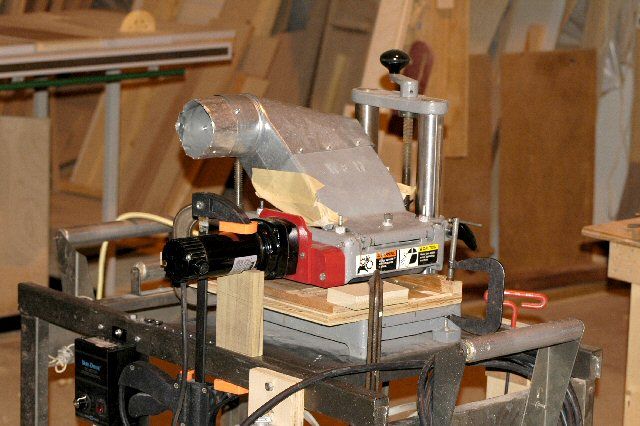Troubleshooting "Chip Beat" with a Small Moulder
Small dents in the finished moulding are a well-known issue, caused by chips and typically related to ineffective dust collection. October 27, 2013
Question
We run a lot of 4 5/8 crown and have some places that seem to me like indentions in the crown that will show up if you don't sand them out. I don't know what causes this, but the cutters are sharp. This isn't wood chipping, it's more like indentations. Any thoughts on what could be causing this? It's not in one certain spot, it's in random spots.
Forum Responses
(Cabinetmaking Forum)
From contributor J:
You need to support the infeed and outfeed portion of the molding, especially on long pieces. If the molding bounces a little or flexes on the ends it will cause the molding to bow up into the knives a little bit. I usually hold the molding up from the infeed side till it gets about halfway. Then I go around to the outfeed side.
From the original questioner:
I know what you are saying, and I do that. But these spots are more random. Like spots as big as a pencil eraser. I only have one thought, and I don't even know if it is possible. Maybe a chip of wood got caught between the cutter and the wood and the cutter was pushing the chip into the wood, creating a dimple in the wood.
From contributor J:
How about wood chips getting on your outfeed roller?
From contributor M:
I think this is exactly what is happening. Do you use dust collection with your Williams and Hussey and is it adequate?
From contributor R:
Could it be little tear outs?
From contributor O:
I also believe it is wood chips being caught between the cutter an the work piece. This will cause small indentions in the wood. You need more suction or a better collection hood.
From the original questioner:
I do use dust collection, but the dust hood is one of the old ones made out of sheet metal. I don't think they make that one anymore, but have a better one available. I'm satisfied that this is the trouble. Now to figure out a solution.
From contributor O:
Maybe for now, try taking a lighter pass so that the chips will be smaller. That could make a difference.
From contributor D:
What you describe is called chipbeat, and occurs when a chip is pressed into the wood by the heel of the knife, leaving an indentation. Most apparent in poplar and maple. The official cause is poor dust collection. And that is the largest contributor. Knife angles also seem to play a role. I can say that there are times when it just seems unavoidable.
From contributor K:
Yep, it sounds like chip beat to me. It happens when my dust chute gets clogged.
From the original questioner:
My normal practice is to do the crown in two passes. The last pass is to take the last 1/16. My dust chute does get clogged from time to time, which is odd because the molder sits right next to the dust collector and we close off the other machines to get more suction. The dust collector I use is made by Grizzly, which is a three hp, the kind with the double collection bags. Maybe I could take another cut after that 1/16 pass that is a 32nd or less and that would clean it up without making many chips to create this problem?
From contributor M:
Try milling within 1/32" of finished depth, empty bags on dust collector to get max efficiency, remove excess chips around machine, then take your final pass.
From contributor L:
This is the best photo I have of my dust hood. It's probably the same type of chute your W&H has. I use a 2 1/2 HP Dust Gorilla and my W&H is at the end of the line. I do close all other gates when I use it.

Click here for higher quality, full size image
Photo by Leo R Graywacz, Jr.
From the original questioner:
Thanks - that is the same chute that I have. Since we are on the subject of these moulders, I was wondering how you like the variable feed system? I have the old gear system on mine which means one speed and gear oil. I've thought about switching over but wondered how good it worked.
From contributor L:
Can't live without it now. I rarely run it at full speed (19 fpm). Usually at about 7 or so. Gets a nice smooth surface and in one pass.
I can do some pretty big moldings because I can go slow. I have one cutter that is really too big for the machine. I run it at a 1/2 foot per minute and the machine still bogs down, and it's poplar. Another HP would be nice, but don't want to damage the machine from excessive torque.
From the original questioner:
Don't they make a roller system for these moulders that make it work like a planer and you can take off a little material at a time? That might not be accurate.
From contributor L:
It's called the two pass system. You can make multiple passes using this system. I think I have it. But I got my machine secondhand and really didn't know much about it when I bought it 15 years ago. I had the standard gear system in it for a long time. Then the original owner came in and wanted to run some molding and he had wood that had a taper on it and it stalled the machine, stripped the brass gear and then I got the variable speed.
